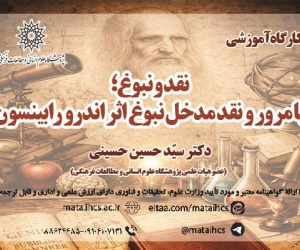Identifying the correctness of interpretive narrations (مقاله علمی وزارت علوم)
درجه علمی: نشریه علمی (وزارت علوم)
آرشیو
چکیده
After the holy Qur'an, hadith is the most important source of knowing the intentions of the verses of the Qur'an, and therefore the recognition of authentic hadiths is very important. From the beginning of Islam, the phenomenon of fabricating hadith by dissidents and hypocrites has a long history and has been used as a weapon. The Holy Prophet (PBUH) and the Imams (AS) and consequently the scholars and scientists of the Islamic religion, by using certain methods, have provided the ground for Muslims to identify the Sanad of the narrations and have thwarted this great conspiracy with special instructions. They used instructions such as the spread of the science of rijāl in order to identify truthful and reliable narrators and reject weak narrators. And in the field of protecting the text of hadiths, they used methods such as presenting hadiths to imams and scholars, comparing manuscripts, allowing the narration of hadiths, listing methods, etc. Therefore, one of the important issues of Islamic sciences in the field of Qur'anic interpretation is the issue of narrative interpretations issued by the Holy Prophet (PBUH) or the Imams (AS).And these interpretations have a lot of confusion and some of them are fake narrations or Isra’iliyyat, and some others are for adaptation rather than interpretation of the verse. Therefore, according to these inconsistencies that exist in the narrative interpretations, the following narrations should be carefully studied based on the guidance of the Infallibles (AS) and their true followers. So by studying the narrative interpretation, we can find some strategies including assimilation, separation and classification of narrations in narrative interpretations. This article is an attempt in this direction that deals with this issue through a descriptive-analytical method.Identifying the correctness of interpretive narrations
After the holy Qur'an, hadith is the most important source of knowing the intentions of the verses of the Qur'an, and therefore the recognition of authentic hadiths is very important. From the beginning of Islam, the phenomenon of fabricating hadith by dissidents and hypocrites has a long history and has been used as a weapon. The Holy Prophet (PBUH) and the Imams (AS) and consequently the scholars and scientists of the Islamic religion, by using certain methods, have provided the ground for Muslims to identify the Sanad of the narrations and have thwarted this great conspiracy with special instructions. They used instructions such as the spread of the science of rijāl in order to identify truthful and reliable narrators and reject weak narrators. And in the field of protecting the text of hadiths, they used methods such as presenting hadiths to imams and scholars, comparing manuscripts, allowing the narration of hadiths, listing methods, etc. Therefore, one of the important issues of Islamic sciences in the field of Qur'anic interpretation is the issue of narrative interpretations issued by the Holy Prophet (PBUH) or the Imams (AS).And these interpretations have a lot of confusion and some of them are fake narrations or Isra’iliyyat, and some others are for adaptation rather than interpretation of the verse. Therefore, according to these inconsistencies that exist in the narrative interpretations, the following narrations should be carefully studied based on the guidance of the Infallibles (AS) and their true followers. So by studying the narrative interpretation, we can find some strategies including assimilation, separation and classification of narrations in narrative interpretations. This article is an attempt in this direction that deals with this issue through a descriptive-analytical method.









